Dural Graft Market
Dural Graft Market Size and Share Forecast Outlook 2025 to 2035
The dural graft market is projected to grow from USD 650.0 million in 2025 to USD 1,058.8 million by 2035, at a CAGR of 5.0%. Xenograft will dominate with a 40.0% market share, while neurosurgery will lead the application segment with a 70.0% share.
Dural Graft Market Forecast and Outlook 2025 to 2035
The dural graft market stands at the threshold of a decade-long expansion trajectory that promises to reshape neurosurgical treatment methodologies and cranial repair solutions. The market's journey from USD 650.0 million in 2025 to USD 1,060.0 million by 2035 represents substantial growth, the market will rise at a CAGR of 5.0% which demonstrating the accelerating adoption of advanced graft materials and precision repair optimization across neurosurgical facilities, hospital operations, and specialized medical centers.
The first half of the decade (2025-2030) will witness the market climbing from USD 650.0 million to approximately USD 850.0 million, adding USD 200.0 million in value, which constitutes 49% of the total forecast growth period. This phase will be characterized by the rapid adoption of xenograft dural repair systems, driven by increasing neurosurgical procedures and the growing need for advanced repair solutions worldwide. Enhanced biocompatibility and automated processing systems will become standard expectations rather than premium options.
The latter half (2030-2035) will witness continued growth from USD 850.0 million to USD 1,060.0 million, representing an addition of USD 210.0 million or 51% of the decade's expansion. This period will be defined by mass market penetration of synthetic graft technologies, integration with comprehensive surgical management platforms, and seamless compatibility with existing neurosurgical infrastructure. The market trajectory signals fundamental shifts in how medical facilities approach dural repair and surgical outcomes, with participants positioned to benefit from growing demand across multiple material types and application segments.
Quick Stats for Dural Graft Market
- Dural Graft Market Value (2025): USD 650.0 million
- Dural Graft Market Forecast Value (2035): USD 1,060.0 million
- Dural Graft Market Forecast CAGR: 5.0%
- Leading Material Type in Dural Graft Market: Xenograft Materials
- Key Growth Regions in Dural Graft Market: North America, East Asia, and Western Europe
- Top Players in Dural Graft Market: Integra LifeSciences, Medtronic, Baxter, Stryker, B Braun
- Where revenue comes from - now vs next (industry-level view)
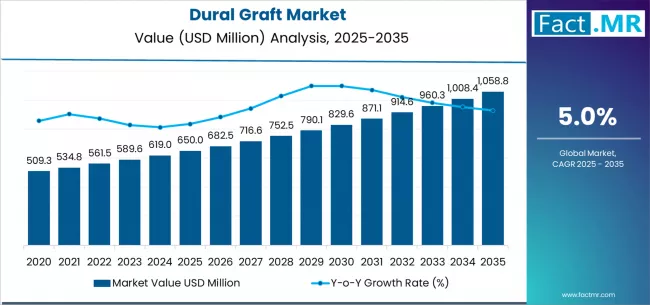
| Period | Primary Revenue Buckets | Share | Notes |
|---|---|---|---|
| Today | New graft sales (xenograft, allograft, synthetic) | 60% | Volume-driven, procedure-based purchases |
| Processing & preparation services | 20% | Sterilization, sizing, custom preparation | |
| Training & education programs | 12% | Surgical technique, handling protocols | |
| Research & development partnerships | 8% | Clinical trials, product development | |
| Future (3-5 yrs) | Advanced xenograft systems | 45-50% | Enhanced biocompatibility, faster integration |
| Digital tracking & analytics | 15-20% | Outcome monitoring, surgical analytics | |
| Service-as-a-solution | 15-20% | Complete surgical packages, outcome guarantees | |
| Synthetic innovations | 10-15% | Bioengineered materials, custom solutions | |
| Training & certification | 8-12% | Advanced surgical techniques, compliance | |
| Data services (outcomes, benchmarking) | 5-8% | Performance metrics for surgical teams |
Dural Graft Market Key Takeaways
At-a-Glance Metrics
| Metric | Value |
|---|---|
| Market Value (2025) → | USD 650.0 million |
| Market Forecast (2035) ↑ | USD 1,060.0 million |
| Growth Rate ★ | 5.0% CAGR |
| Leading Material → | Xenograft Materials |
| Primary Application → | Neurosurgery Segment |
The market demonstrates strong fundamentals with xenograft materials capturing a dominant share through advanced biocompatibility and surgical integration capabilities. Neurosurgery applications drive primary demand, supported by increasing cranial procedures and surgical repair requirements. Geographic expansion remains concentrated in developed markets with established neurosurgical infrastructure, while emerging economies show accelerating adoption rates driven by medical facility modernization and rising surgical standards.
Imperatives for Stakeholders in Dural Graft Market
Design for biocompatibility, not just availability
- Offer comprehensive surgical packages: graft materials + surgical protocols + documentation + trained technicians + clinical support.
- Preconfigured workflows: sterilization validation, handling procedures, surgical records, and digital tracking systems on surgical outcomes.
Clinical readiness integration
- Real-time outcome monitoring analytics, predictive healing capabilities, and advanced surgical integration (electronic health records connectivity, patient tracking systems).
Quality-by-design approach
- Automated compatibility testing systems, real-time rejection prevention mechanisms, clinical outcome integration, and paperless surgical documentation.
Value-based pricing models
- Clear base graft price + transparent service tiers (clinical support, availability guarantees, outcome tracking); subscriptions for digital services and analytics.
Segmental Analysis
The market is segmented by material type into xenograft, allograft, and synthetic dural grafts, representing the evolution from traditional repair materials to sophisticated biological solutions for comprehensive neurosurgical optimization.
The application segmentation divides the market into neurosurgery and ENT/spinal applications, reflecting distinct requirements for surgical procedures, clinical outcomes, and facility specialization standards.
Regional distribution covers North America, Latin America, Western Europe, Eastern Europe, East Asia, South Asia Pacific, and Middle East & Africa, with developed markets leading adoption while emerging economies show accelerating growth patterns driven by neurosurgical expansion programs.
The segmentation structure reveals material progression from standard repair solutions toward advanced biological systems with enhanced biocompatibility and integration capabilities, while application diversity spans from neurosurgical facilities to specialized ENT operations requiring precise repair solutions.
By Material Type, the Xenograft Segment Accounts for Dominant Market Share
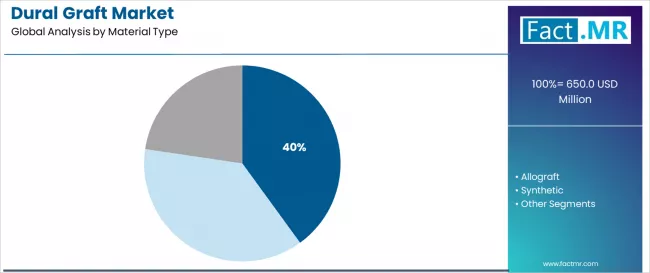
Xenograft materials command the leading position in the dural graft market with 40.0% market share through advanced biological features, including superior biocompatibility, surgical integration, and neurosurgical optimization that enable medical facilities to achieve optimal repair outcomes across diverse neurosurgical and cranial environments.
The segment benefits from neurosurgical facility preference for reliable graft materials that provide consistent healing performance, reduced rejection rates, and surgical efficiency optimization without requiring significant procedural modifications. Advanced biological features enable automated compatibility systems, integration consistency, and compatibility with existing neurosurgical equipment, where surgical performance and clinical outcomes represent critical facility requirements.
Xenograft materials differentiate through proven surgical reliability, consistent healing characteristics, and integration with advanced neurosurgical systems that enhance facility effectiveness while maintaining optimal clinical standards suitable for diverse neurosurgical and cranial applications.
Key market characteristics:
- Advanced biological designs with optimized compatibility configuration and surgical efficiency capabilities
- Enhanced healing effectiveness, enabling 95-98% integration success with consistent clinical performance
- Neurosurgical compatibility, including automated quality systems, monitoring integration, and process optimization for repair operations
Allograft Materials Show Balanced Market Growth
Allograft materials maintain a 35.0% market position in the dural graft market due to their balanced biological properties and clinical advantages. These materials appeal to facilities requiring proven compatibility with competitive pricing for neurosurgical applications. Market growth is driven by surgical expansion, emphasizing reliable graft solutions and clinical efficiency through optimized material designs.
Synthetic Materials Demonstrate Specialized Growth
Synthetic materials capture 25.0% market share through specialized repair requirements in complex procedures, custom applications, and development scenarios. These facilities demand flexible graft materials capable of handling diverse surgical conditions while providing effective repair capabilities and clinical reliability.
By Application, the Neurosurgery Segment Shows Market Leadership
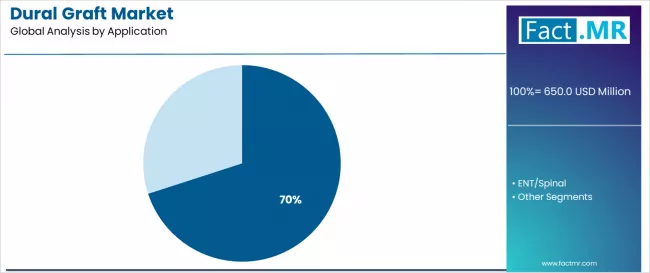
Neurosurgery applications demonstrate the highest market share in the dural graft market with 70.0% dominance due to widespread adoption of cranial repair systems and increasing focus on neurosurgical optimization, clinical outcomes, and facility specialization applications that maximize surgical success while maintaining quality standards.
Neurosurgery operators prioritize material reliability, surgical integration, and compatibility with existing neurosurgical infrastructure that enables coordinated repair operations across multiple surgical procedures. The segment benefits from substantial neurosurgical investment and modernization programs that emphasize the acquisition of advanced graft materials for surgical optimization and clinical excellence applications.
Neurosurgical expansion programs incorporate dural grafts as standard materials for surgical operations, while specialized facility growth increases demand for reliable repair capabilities that comply with clinical standards and minimize surgical complexity.
Application dynamics include:
- Strong growth in neurosurgical procedures and cranial repair requiring advanced material capabilities
- Increasing adoption in surgical optimization and clinical excellence applications for neurosurgical operators
- Rising integration with advanced surgical systems for operational optimization and outcome assurance
ENT/Spinal Applications Maintain Specialized Demand
ENT/Spinal applications capture 30.0% market share through specialized repair requirements in otolaryngology procedures, spinal operations, and specialized applications. These facilities demand flexible surgical materials capable of operating with diverse procedural conditions while providing effective repair access and clinical reliability capabilities.
What are the Drivers, Restraints, and Key Trends of the Dural Graft Market?
| Category | Factor | Impact | Why It Matters |
|---|---|---|---|
| Driver | Aging population & increased neurosurgical procedures (demographic trends, medical advancement) | ★★★★★ | Growing elderly population requires more cranial surgeries; creates consistent demand for reliable graft materials with proven clinical outcomes across surgical procedures. |
| Driver | Clinical outcomes & biocompatibility requirements (FDA, CE marking standards) | ★★★★★ | Turns advanced graft materials from "optional" to "mandatory"; vendors that provide clinical validation and compatibility documentation gain competitive advantage. |
| Driver | Minimally invasive surgery expansion & technique advancement | ★★★★☆ | Surgeons need compatible, easy-to-handle materials; demand for flexible application and reliable integration expanding addressable market opportunities. |
| Restraint | High material costs & clinical validation expenses (especially for smaller hospitals) | ★★★★☆ | Small medical facilities defer purchases; increases price sensitivity and slows advanced material adoption in emerging healthcare markets. |
| Restraint | Complex sterilization & handling requirements | ★★★☆☆ | Multi-procedure facilities face lengthy preparation procedures and validation requirements, limiting operational flexibility and increasing complexity. |
| Trend | Digital integration & surgical analytics | ★★★★★ | Real-time outcome monitoring, predictive healing analytics, and surgical data transform operations; connectivity and digital tracking become core value propositions. |
| Trend | Personalized medicine & custom graft solutions | ★★★★☆ | Flexible graft materials for specialized applications; modular designs and custom preparation capabilities drive competition toward individualized solutions. |
Analysis of the Dural Graft Market by Key Country
The dural graft market demonstrates varied regional dynamics with Growth Leaders including India (7.0% growth rate) and China (6.0% growth rate) driving expansion through neurosurgical facility development and medical capacity advancement. Steady Performers encompass Brazil (5.2% growth rate), Germany (4.9% growth rate), and United States (4.8% growth rate), benefiting from established neurosurgical industries and advanced medical adoption. Developed Markets feature Korea (4.7% growth rate) and Japan (4.5% growth rate), where medical infrastructure and clinical modernization support consistent growth patterns.
Regional synthesis reveals Asian markets leading adoption through neurosurgical expansion and medical development, while North American countries maintain steady expansion supported by medical technology advancement and regulatory standardization requirements. European markets show moderate growth driven by neurosurgical applications and clinical integration trends.
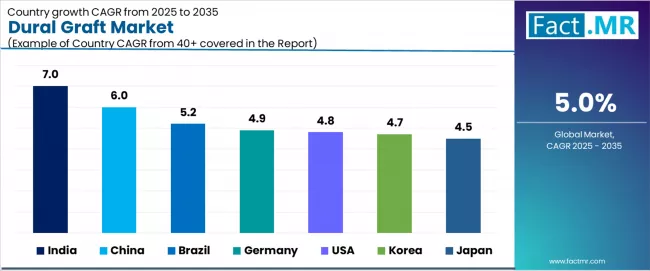
| Region/Country | 2025-2035 Growth | How to win | What to watch out |
|---|---|---|---|
| India | 7.0% | Focus on cost-effective materials | Regulatory changes; price competition |
| China | 6.0% | Lead with advanced biocompatibility | Import requirements; clinical validation |
| Brazil | 5.2% | Provide clinical support | Currency fluctuations; regulatory compliance |
| Germany | 4.9% | Offer premium precision materials | Over-regulation; lengthy approval cycles |
| United States | 4.8% | Provide validation support | FDA compliance costs; reimbursement challenges |
| Korea | 4.7% | Push digital integration | Technology adoption barriers; cost pressures |
| Japan | 4.5% | Focus on quality systems | Aging infrastructure; conservative adoption |
India Drives Fastest Market Growth
India establishes fastest market growth through aggressive neurosurgical facility programs and comprehensive medical capacity development, integrating advanced dural graft materials as standard components in cranial procedures and neurosurgical installations. The country's 7.0% growth rate reflects government initiatives promoting medical infrastructure and healthcare capabilities that mandate the use of advanced graft systems in neurosurgical and specialized medical facilities. Growth concentrates in major medical hubs, including Delhi, Mumbai, and Bangalore, where neurosurgical technology development showcases integrated graft systems that appeal to medical operators seeking advanced surgical optimization capabilities and clinical management applications.
Indian manufacturers are developing cost-effective graft solutions that combine domestic production advantages with advanced clinical features, including automated compatibility systems and enhanced biointegration capabilities. Distribution channels through medical equipment suppliers and healthcare service distributors expand market access, while government support for medical infrastructure supports adoption across diverse neurosurgical and clinical segments.
Strategic Market Indicators:
- Neurosurgical facilities leading adoption with 78% deployment rate in cranial and spinal procedure sectors
- Government healthcare programs providing substantial funding for domestic medical technology development
- Local manufacturers capturing 42% market share through competitive pricing and localized clinical support
- Export market development for cost-effective graft solutions targeting emerging medical markets
China Emerges as High-Growth Market
In Beijing, Shanghai, and Guangzhou, neurosurgical facilities and medical centers are implementing advanced dural graft materials as standard components for surgical optimization and clinical compliance applications, driven by increasing government medical investment and healthcare modernization programs that emphasize the importance of biocompatibility capabilities.
The market holds a 6.0% growth rate, supported by government healthcare initiatives and medical infrastructure development programs that promote advanced graft systems for neurosurgical and specialized medical facilities. Chinese operators are adopting graft materials that provide consistent clinical performance and outcome compliance features, particularly appealing in urban regions where surgical efficiency and clinical standards represent critical operational requirements.
Market expansion benefits from growing neurosurgical capabilities and international technology transfer agreements that enable domestic production of advanced graft systems for neurosurgical and medical applications. Technology adoption follows patterns established in medical equipment, where reliability and performance drive procurement decisions and clinical deployment.
Market Intelligence Brief:
- Neurosurgical and specialized medical segments are driving initial adoption with 52% annual growth in material procurement
- Healthcare modernization programs emphasizing graft materials for surgical efficiency and clinical compliance
- Local manufacturers partnering with international providers for system development
- Medical facilities implementing graft materials for surgical optimization and outcome management
Brazil Shows Strong Regional Leadership
Brazil's market expansion benefits from diverse neurosurgical demand, including medical modernization in São Paulo and Rio de Janeiro, neurosurgical facility upgrades, and government healthcare programs that increasingly incorporate graft solutions for surgical optimization applications. The country maintains a 5.2% growth rate, driven by rising neurosurgical activity and increasing recognition of graft material benefits, including precise repair control and enhanced surgical efficiency.
Market dynamics focus on cost-effective graft solutions that balance advanced clinical performance with affordability considerations important to Brazilian medical operators. Growing medical industrialization creates continued demand for modern graft materials in new facility infrastructure and healthcare modernization projects.
Strategic Market Considerations:
- Neurosurgical and specialized medical segments leading growth with focus on surgical optimization and clinical compliance applications
- Regional healthcare requirements driving a diverse product portfolio from basic graft materials to advanced systems
- Import dependency challenges offset by potential local production partnerships with international manufacturers
- Government healthcare initiatives beginning to influence procurement standards and clinical requirements
Germany Shows Technology Leadership
Germany's advanced medical technology market demonstrates sophisticated dural graft material deployment with documented clinical effectiveness in neurosurgical applications and medical facilities through integration with existing quality systems and medical infrastructure.
The country leverages engineering expertise in medical technology and quality systems integration to maintain a 4.9% growth rate. Industrial centers, including Baden-Württemberg, Bavaria, and North Rhine-Westphalia, showcase premium installations where graft materials integrate with comprehensive medical platforms and facility management systems to optimize surgical operations and clinical effectiveness.
German manufacturers prioritize material precision and EU compliance in graft development, creating demand for premium materials with advanced features, including facility monitoring integration and automated quality systems. The market benefits from established medical technology infrastructure and a willingness to invest in advanced healthcare technologies that provide long-term clinical benefits and compliance with international medical standards.
Market Intelligence Brief:
- Engineering focuses on EU standardization and clinical compliance, driving premium segment growth
- Medical technology partnerships providing 28% faster development cycles
- Technology collaboration between German manufacturers and international medical companies
- Facility training programs expanding graft material integration in neurosurgical scenarios
United States Maintains Market Leadership
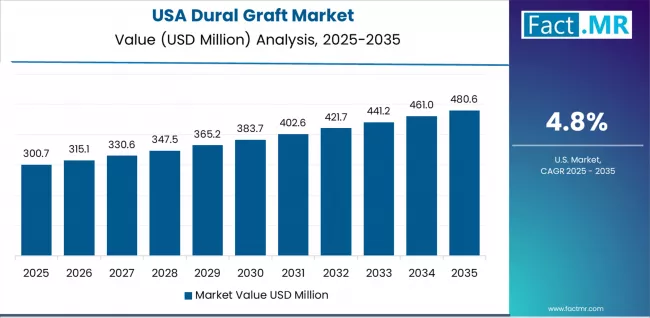
United States establishes market leadership through comprehensive neurosurgical programs and advanced medical infrastructure development, integrating dural graft materials across neurosurgical and specialized medical applications. The country's 4.8% growth rate reflects established neurosurgical industry relationships and mature graft technology adoption that supports widespread use of precision graft materials in neurosurgical and medical facilities. Growth concentrates in major medical centers, including Massachusetts, California, and Texas, where medical technology showcases mature graft deployment that appeals to medical operators seeking proven precision graft capabilities and clinical efficiency applications.
American material providers leverage established distribution networks and comprehensive service capabilities, including clinical validation programs and support services that create customer relationships and operational advantages. The market benefits from mature regulatory standards and medical requirements that mandate graft material use while supporting technology advancement and clinical optimization.
Market Intelligence Brief:
- Neurosurgical and medical facilities maintaining 85% adoption rate with mature graft deployment
- Established regulatory standards providing consistent demand for graft technology advancement
- Specialized medical networks capturing 68% market share through clinical flexibility and outcome efficiency
- Technology integration programs expanding graft capabilities in neurosurgical scenarios
Korea Shows Digital Integration Focus
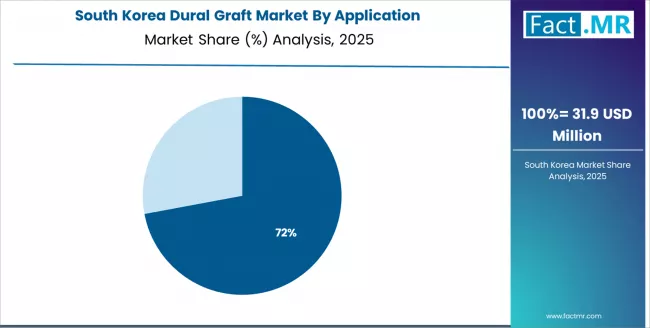
Korea's advanced medical technology market demonstrates sophisticated dural graft material deployment with comprehensive digital integration and outcome monitoring capabilities. The country maintains a 4.7% growth rate through advanced medical infrastructure and technology adoption programs. Medical centers in Seoul, Busan, and Incheon showcase integrated installations where graft materials connect with comprehensive medical platforms and digital outcome systems to optimize surgical effectiveness and clinical performance.
Korean medical facilities prioritize digital integration and outcome analytics in graft material adoption, creating demand for connected materials with advanced monitoring capabilities. The market benefits from government medical technology investment and healthcare modernization initiatives that promote digital health solutions.
Market Intelligence Brief:
- Digital integration driving 45% of new graft material adoptions with outcome monitoring capabilities
- Government healthcare digitization programs providing infrastructure support
- Medical technology partnerships expanding digital capabilities in neurosurgical applications
- Clinical training programs emphasizing digital integration and outcome analytics
Japan Shows Quality Leadership
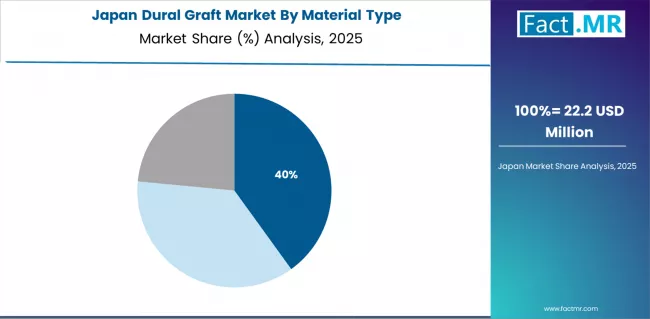
Japan maintains a 4.5% growth rate through established medical technology infrastructure and comprehensive quality management programs. The country's medical facilities demonstrate sophisticated graft material integration with emphasis on clinical outcomes and quality assurance across neurosurgical and specialized medical applications.
Japanese medical operators prioritize material reliability and clinical consistency in graft adoption, while established quality standards and medical requirements create continued demand for advanced graft materials with proven clinical effectiveness.
Market Intelligence Brief:
- Quality-focused adoption with 82% emphasis on clinical outcomes and material reliability
- Established medical technology infrastructure supporting advanced graft material integration
- Medical facility modernization programs expanding graft capabilities
- Clinical excellence initiatives driving demand for premium graft materials
Europe Market Split by Country
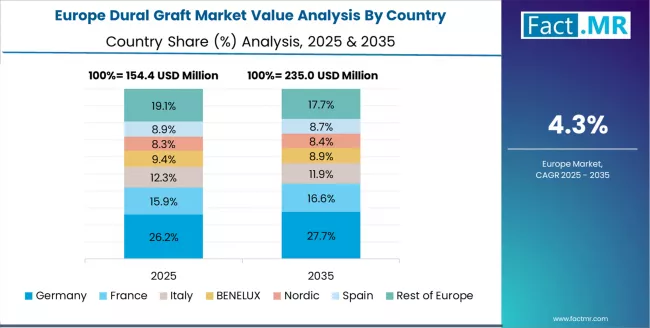
The European dural graft market is projected to grow from USD 520.0 million in 2025 to USD 850.0 million by 2035, registering a CAGR of 5.0% over the forecast period. Germany is expected to maintain its leadership position with a 21.2% share in 2025, supported by its advanced neurosurgical technology infrastructure and major medical centers.
France follows with a 17.3% share in 2025, driven by comprehensive neurosurgical programs and medical technology development initiatives. The United Kingdom holds a 16.3% share through specialized neurosurgical applications and clinical compliance requirements. Italy commands a 14.4% share, while Spain accounts for 12.5% in 2025. The Rest of Europe region represents 18.3%, attributed to increasing neurosurgical adoption in Nordic countries and emerging medical facilities implementing healthcare modernization programs.
By 2035, the market structure is expected to remain relatively balanced, with Germany maintaining its lead and gradual share gains seen in mid-sized European economies as neurosurgical access and healthcare modernization expand.
Competitive Landscape of the Dural Graft Market
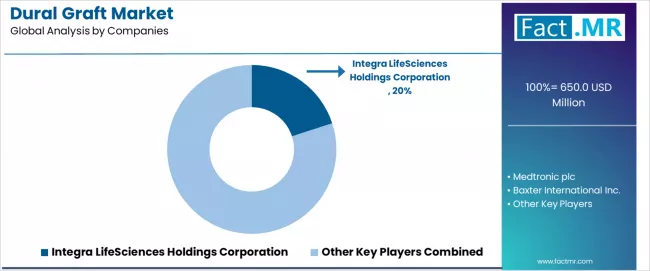
- Structure: 12-15 credible players; top 3-5 hold 60-65% by revenue.
- Leadership is maintained through: clinical validation networks, biocompatibility support, and material innovation (integration + compatibility + clinical outcomes).
- What's commoditizing: basic graft materials and standard sterilization processes.
- Margin Opportunities: clinical validation services, outcome tracking, and integration into surgical workflows (EHR/surgical systems, digital outcome records).
| Stakeholder | What they actually control | Typical strengths | Typical blind spots |
|---|---|---|---|
| Global platforms | Distribution reach, deep clinical portfolios, service networks | Broad availability, proven reliability, multi-region support | Technology refresh cycles; customer dependency |
| Technology innovators | R&D capabilities; advanced biocompatibility; clean digital interfaces | Latest features first; attractive ROI on high-volume procedures | Service density outside core regions; customization complexity |
| Regional specialists | Local compliance, fast delivery, nearby clinical support | "Close to facility" support; pragmatic pricing; local regulations | Technology gaps; talent retention in clinical services |
| Service-focused ecosystems | Clinical validation support, outcome tracking, material availability | Lowest real complications; comprehensive clinical support | Service costs if overpromised; material obsolescence |
| Niche specialists | Specialized applications, custom solutions, R&D support | Win research/development applications; flexible configurations | Scalability limitations; narrow market focus |
Key Players in the Dural Graft Market
- Integra LifeSciences Holdings Corporation
- Medtronic plc
- Baxter International Inc.
- Stryker Corporation
- B. Braun Melsungen AG
- DePuy Synthes, Inc. (Johnson & Johnson)
- Cook Biotech Inc. / Cook Medical
- Aesculap Inc.
- Zimmer Biomet Holdings, Inc.
- Collagen Matrix Inc.
- RTI Surgical Holdings, Inc.
- Natus Medical Incorporated
- Durepair (now part of Integra LifeSciences)
- Medprin Biotech GmbH
- Shanghai Tuoren Medical Technology Co. Ltd.
Scope of the Report
| Item | Value |
|---|---|
| Quantitative Units (2025) | USD 650.0 million |
| Material Type | Xenograft, Allograft, Synthetic |
| Application | Neurosurgery, ENT/Spinal |
| Regions Covered | North America, Latin America, Western Europe, Eastern Europe, East Asia, South Asia Pacific, Middle East & Africa |
| Countries Covered | United States, China, Germany, India, United Kingdom, Japan, Canada, Brazil, France, Australia, Korea, and 25+ additional countries |
| Key Companies Profiled | Integra LifeSciences, Medtronic, Baxter, Stryker, B Braun, DePuy Synthes, Cook Biotech, Aesculap, Zimmer Biomet, Collagen Matrix, RTI Surgical, Natus Medical, Durepair, Medprin, Shanghai Tuoren |
| Additional Attributes | Dollar sales by material type and application categories, regional adoption trends across North America, East Asia, and Western Europe, competitive landscape with medical equipment manufacturers and neurosurgical suppliers, surgical operator preferences for biocompatibility control and material reliability, integration with medical platforms and outcome monitoring systems. |
Dural Graft Market by Segments
-
Material Type:
- Xenograft
- Allograft
- Synthetic
-
Application:
- Neurosurgery
- ENT/Spinal
-
Region:
- North America
- United States
- Canada
- Mexico
- Latin America
- Brazil
- Chile
- Rest of Latin America
- Western Europe
- Germany
- United Kingdom
- France
- Italy
- Spain
- Nordic
- BENELUX
- Rest of Western Europe
- Eastern Europe
- Russia
- Poland
- Rest of Eastern Europe
- East Asia
- China
- Japan
- South Korea
- South Asia Pacific
- India
- ASEAN
- Australia & New Zealand
- Rest of South Asia Pacific
- Middle East & Africa
- Kingdom of Saudi Arabia
- Other GCC Countries
- Turkey
- South Africa
- Other African Union
- Rest of Middle East & Africa
- North America
Table of Content
- Executive Summary
- Market Overview
- Market Background
- Global Market Analysis 2019 to 2023 and Forecast, 2024 to 2034
- Global Market Analysis 2019 to 2023 and Forecast 2024 to 2034, By Product
- Xenogeneic Dural Graft
- Allogenic Dural Graft
- Synthetic Dural Graft
- Autologous Dural Graft
- Others
- Global Market Analysis 2019 to 2023 and Forecast 2024 to 2034, By Application
- Traumatic Brain and Spine Injury
- Cerebrovascular Accident
- Cerebrospinal Fluid (CSF) Accumulation
- Brain and Spine Tumor
- Epilepsy
- Others
- Global Market Analysis 2019 to 2023 and Forecast 2024 to 2034, By Material Type
- Bovine Pericardium
- Cadaveric Dura
- Autologous Pericardium
- Synthetic Bovine Collagen Matrix
- Ligamentum Nuchae
- Others
- Global Market Analysis 2019 to 2023 and Forecast 2024 to 2034, By End User
- Hospitals
- Ambulatory Surgical Centres
- Trauma Centres
- Clinics
- Global Market Analysis 2019 to 2023 and Forecast 2024 to 2034, By Region
- North America
- Latin America
- Western Europe
- Eastern Europe
- South Asia and Pacific
- East Asia
- Middle East and Africa
- North America Market Analysis 2019 to 2023 and Forecast 2024 to 2034, By Country
- Latin America Market Analysis 2019 to 2023 and Forecast 2024 to 2034, By Country
- Western Europe Market Analysis 2019 to 2023 and Forecast 2024 to 2034, By Country
- Eastern Europe Market Analysis 2019 to 2023 and Forecast 2024 to 2034, By Country
- South Asia and Pacific Market Analysis 2019 to 2023 and Forecast 2024 to 2034, By Country
- East Asia Market Analysis 2019 to 2023 and Forecast 2024 to 2034, By Country
- Middle East and Africa Market Analysis 2019 to 2023 and Forecast 2024 to 2034, By Country
- Key Countries Market Analysis
- Market Structure Analysis
- Competition Analysis
- Cook Medical
- Integra Lifesciences Corporation
- B Braun
- Cousin Biotech
- Natus Medical Incorporated
- Tissuemed Ltd
- Vostra Gmbh
- Stryker Corporation
- Medtronic Plc
- Johnson & Johnson
- Baxter International Inc
- Assumptions & Acronyms Used
- Research Methodology
List Of Table
- Table 1: Global Market Value (US$ Million) Forecast by Region, 2019 to 2034
- Table 2: Global Market Value (US$ Million) Forecast by Product, 2019 to 2034
- Table 3: Global Market Value (US$ Million) Forecast by Application, 2019 to 2034
- Table 4: Global Market Value (US$ Million) Forecast by Material Type, 2019 to 2034
- Table 5: Global Market Value (US$ Million) Forecast by End User, 2019 to 2034
- Table 6: North America Market Value (US$ Million) Forecast by Country, 2019 to 2034
- Table 7: North America Market Value (US$ Million) Forecast by Product, 2019 to 2034
- Table 8: North America Market Value (US$ Million) Forecast by Application, 2019 to 2034
- Table 9: North America Market Value (US$ Million) Forecast by Material Type, 2019 to 2034
- Table 10: North America Market Value (US$ Million) Forecast by End User, 2019 to 2034
- Table 11: Latin America Market Value (US$ Million) Forecast by Country, 2019 to 2034
- Table 12: Latin America Market Value (US$ Million) Forecast by Product, 2019 to 2034
- Table 13: Latin America Market Value (US$ Million) Forecast by Application, 2019 to 2034
- Table 14: Latin America Market Value (US$ Million) Forecast by Material Type, 2019 to 2034
- Table 15: Latin America Market Value (US$ Million) Forecast by End User, 2019 to 2034
- Table 16: Western Europe Market Value (US$ Million) Forecast by Country, 2019 to 2034
- Table 17: Western Europe Market Value (US$ Million) Forecast by Product, 2019 to 2034
- Table 18: Western Europe Market Value (US$ Million) Forecast by Application, 2019 to 2034
- Table 19: Western Europe Market Value (US$ Million) Forecast by Material Type, 2019 to 2034
- Table 20: Western Europe Market Value (US$ Million) Forecast by End User, 2019 to 2034
- Table 21: Eastern Europe Market Value (US$ Million) Forecast by Country, 2019 to 2034
- Table 22: Eastern Europe Market Value (US$ Million) Forecast by Product, 2019 to 2034
- Table 23: Eastern Europe Market Value (US$ Million) Forecast by Application, 2019 to 2034
- Table 24: Eastern Europe Market Value (US$ Million) Forecast by Material Type, 2019 to 2034
- Table 25: Eastern Europe Market Value (US$ Million) Forecast by End User, 2019 to 2034
- Table 26: South Asia and Pacific Market Value (US$ Million) Forecast by Country, 2019 to 2034
- Table 27: South Asia and Pacific Market Value (US$ Million) Forecast by Product, 2019 to 2034
- Table 28: South Asia and Pacific Market Value (US$ Million) Forecast by Application, 2019 to 2034
- Table 29: South Asia and Pacific Market Value (US$ Million) Forecast by Material Type, 2019 to 2034
- Table 30: South Asia and Pacific Market Value (US$ Million) Forecast by End User, 2019 to 2034
- Table 31: East Asia Market Value (US$ Million) Forecast by Country, 2019 to 2034
- Table 32: East Asia Market Value (US$ Million) Forecast by Product, 2019 to 2034
- Table 33: East Asia Market Value (US$ Million) Forecast by Application, 2019 to 2034
- Table 34: East Asia Market Value (US$ Million) Forecast by Material Type, 2019 to 2034
- Table 35: East Asia Market Value (US$ Million) Forecast by End User, 2019 to 2034
- Table 36: Middle East and Africa Market Value (US$ Million) Forecast by Country, 2019 to 2034
- Table 37: Middle East and Africa Market Value (US$ Million) Forecast by Product, 2019 to 2034
- Table 38: Middle East and Africa Market Value (US$ Million) Forecast by Application, 2019 to 2034
- Table 39: Middle East and Africa Market Value (US$ Million) Forecast by Material Type, 2019 to 2034
- Table 40: Middle East and Africa Market Value (US$ Million) Forecast by End User, 2019 to 2034
List Of Figures
- Figure 1: Global Market Value (US$ Million) by Product, 2024 to 2034
- Figure 2: Global Market Value (US$ Million) by Application, 2024 to 2034
- Figure 3: Global Market Value (US$ Million) by Material Type, 2024 to 2034
- Figure 4: Global Market Value (US$ Million) by End User, 2024 to 2034
- Figure 5: Global Market Value (US$ Million) by Region, 2024 to 2034
- Figure 6: Global Market Value (US$ Million) Analysis by Region, 2019 to 2034
- Figure 7: Global Market Value Share (%) and BPS Analysis by Region, 2024 to 2034
- Figure 8: Global Market Y-o-Y Growth (%) Projections by Region, 2024 to 2034
- Figure 9: Global Market Value (US$ Million) Analysis by Product, 2019 to 2034
- Figure 10: Global Market Value Share (%) and BPS Analysis by Product, 2024 to 2034
- Figure 11: Global Market Y-o-Y Growth (%) Projections by Product, 2024 to 2034
- Figure 12: Global Market Value (US$ Million) Analysis by Application, 2019 to 2034
- Figure 13: Global Market Value Share (%) and BPS Analysis by Application, 2024 to 2034
- Figure 14: Global Market Y-o-Y Growth (%) Projections by Application, 2024 to 2034
- Figure 15: Global Market Value (US$ Million) Analysis by Material Type, 2019 to 2034
- Figure 16: Global Market Value Share (%) and BPS Analysis by Material Type, 2024 to 2034
- Figure 17: Global Market Y-o-Y Growth (%) Projections by Material Type, 2024 to 2034
- Figure 18: Global Market Value (US$ Million) Analysis by End User, 2019 to 2034
- Figure 19: Global Market Value Share (%) and BPS Analysis by End User, 2024 to 2034
- Figure 20: Global Market Y-o-Y Growth (%) Projections by End User, 2024 to 2034
- Figure 21: Global Market Attractiveness by Product, 2024 to 2034
- Figure 22: Global Market Attractiveness by Application, 2024 to 2034
- Figure 23: Global Market Attractiveness by Material Type, 2024 to 2034
- Figure 24: Global Market Attractiveness by End User, 2024 to 2034
- Figure 25: Global Market Attractiveness by Region, 2024 to 2034
- Figure 26: North America Market Value (US$ Million) by Product, 2024 to 2034
- Figure 27: North America Market Value (US$ Million) by Application, 2024 to 2034
- Figure 28: North America Market Value (US$ Million) by Material Type, 2024 to 2034
- Figure 29: North America Market Value (US$ Million) by End User, 2024 to 2034
- Figure 30: North America Market Value (US$ Million) by Country, 2024 to 2034
- Figure 31: North America Market Value (US$ Million) Analysis by Country, 2019 to 2034
- Figure 32: North America Market Value Share (%) and BPS Analysis by Country, 2024 to 2034
- Figure 33: North America Market Y-o-Y Growth (%) Projections by Country, 2024 to 2034
- Figure 34: North America Market Value (US$ Million) Analysis by Product, 2019 to 2034
- Figure 35: North America Market Value Share (%) and BPS Analysis by Product, 2024 to 2034
- Figure 36: North America Market Y-o-Y Growth (%) Projections by Product, 2024 to 2034
- Figure 37: North America Market Value (US$ Million) Analysis by Application, 2019 to 2034
- Figure 38: North America Market Value Share (%) and BPS Analysis by Application, 2024 to 2034
- Figure 39: North America Market Y-o-Y Growth (%) Projections by Application, 2024 to 2034
- Figure 40: North America Market Value (US$ Million) Analysis by Material Type, 2019 to 2034
- Figure 41: North America Market Value Share (%) and BPS Analysis by Material Type, 2024 to 2034
- Figure 42: North America Market Y-o-Y Growth (%) Projections by Material Type, 2024 to 2034
- Figure 43: North America Market Value (US$ Million) Analysis by End User, 2019 to 2034
- Figure 44: North America Market Value Share (%) and BPS Analysis by End User, 2024 to 2034
- Figure 45: North America Market Y-o-Y Growth (%) Projections by End User, 2024 to 2034
- Figure 46: North America Market Attractiveness by Product, 2024 to 2034
- Figure 47: North America Market Attractiveness by Application, 2024 to 2034
- Figure 48: North America Market Attractiveness by Material Type, 2024 to 2034
- Figure 49: North America Market Attractiveness by End User, 2024 to 2034
- Figure 50: North America Market Attractiveness by Country, 2024 to 2034
- Figure 51: Latin America Market Value (US$ Million) by Product, 2024 to 2034
- Figure 52: Latin America Market Value (US$ Million) by Application, 2024 to 2034
- Figure 53: Latin America Market Value (US$ Million) by Material Type, 2024 to 2034
- Figure 54: Latin America Market Value (US$ Million) by End User, 2024 to 2034
- Figure 55: Latin America Market Value (US$ Million) by Country, 2024 to 2034
- Figure 56: Latin America Market Value (US$ Million) Analysis by Country, 2019 to 2034
- Figure 57: Latin America Market Value Share (%) and BPS Analysis by Country, 2024 to 2034
- Figure 58: Latin America Market Y-o-Y Growth (%) Projections by Country, 2024 to 2034
- Figure 59: Latin America Market Value (US$ Million) Analysis by Product, 2019 to 2034
- Figure 60: Latin America Market Value Share (%) and BPS Analysis by Product, 2024 to 2034
- Figure 61: Latin America Market Y-o-Y Growth (%) Projections by Product, 2024 to 2034
- Figure 62: Latin America Market Value (US$ Million) Analysis by Application, 2019 to 2034
- Figure 63: Latin America Market Value Share (%) and BPS Analysis by Application, 2024 to 2034
- Figure 64: Latin America Market Y-o-Y Growth (%) Projections by Application, 2024 to 2034
- Figure 65: Latin America Market Value (US$ Million) Analysis by Material Type, 2019 to 2034
- Figure 66: Latin America Market Value Share (%) and BPS Analysis by Material Type, 2024 to 2034
- Figure 67: Latin America Market Y-o-Y Growth (%) Projections by Material Type, 2024 to 2034
- Figure 68: Latin America Market Value (US$ Million) Analysis by End User, 2019 to 2034
- Figure 69: Latin America Market Value Share (%) and BPS Analysis by End User, 2024 to 2034
- Figure 70: Latin America Market Y-o-Y Growth (%) Projections by End User, 2024 to 2034
- Figure 71: Latin America Market Attractiveness by Product, 2024 to 2034
- Figure 72: Latin America Market Attractiveness by Application, 2024 to 2034
- Figure 73: Latin America Market Attractiveness by Material Type, 2024 to 2034
- Figure 74: Latin America Market Attractiveness by End User, 2024 to 2034
- Figure 75: Latin America Market Attractiveness by Country, 2024 to 2034
- Figure 76: Western Europe Market Value (US$ Million) by Product, 2024 to 2034
- Figure 77: Western Europe Market Value (US$ Million) by Application, 2024 to 2034
- Figure 78: Western Europe Market Value (US$ Million) by Material Type, 2024 to 2034
- Figure 79: Western Europe Market Value (US$ Million) by End User, 2024 to 2034
- Figure 80: Western Europe Market Value (US$ Million) by Country, 2024 to 2034
- Figure 81: Western Europe Market Value (US$ Million) Analysis by Country, 2019 to 2034
- Figure 82: Western Europe Market Value Share (%) and BPS Analysis by Country, 2024 to 2034
- Figure 83: Western Europe Market Y-o-Y Growth (%) Projections by Country, 2024 to 2034
- Figure 84: Western Europe Market Value (US$ Million) Analysis by Product, 2019 to 2034
- Figure 85: Western Europe Market Value Share (%) and BPS Analysis by Product, 2024 to 2034
- Figure 86: Western Europe Market Y-o-Y Growth (%) Projections by Product, 2024 to 2034
- Figure 87: Western Europe Market Value (US$ Million) Analysis by Application, 2019 to 2034
- Figure 88: Western Europe Market Value Share (%) and BPS Analysis by Application, 2024 to 2034
- Figure 89: Western Europe Market Y-o-Y Growth (%) Projections by Application, 2024 to 2034
- Figure 90: Western Europe Market Value (US$ Million) Analysis by Material Type, 2019 to 2034
- Figure 91: Western Europe Market Value Share (%) and BPS Analysis by Material Type, 2024 to 2034
- Figure 92: Western Europe Market Y-o-Y Growth (%) Projections by Material Type, 2024 to 2034
- Figure 93: Western Europe Market Value (US$ Million) Analysis by End User, 2019 to 2034
- Figure 94: Western Europe Market Value Share (%) and BPS Analysis by End User, 2024 to 2034
- Figure 95: Western Europe Market Y-o-Y Growth (%) Projections by End User, 2024 to 2034
- Figure 96: Western Europe Market Attractiveness by Product, 2024 to 2034
- Figure 97: Western Europe Market Attractiveness by Application, 2024 to 2034
- Figure 98: Western Europe Market Attractiveness by Material Type, 2024 to 2034
- Figure 99: Western Europe Market Attractiveness by End User, 2024 to 2034
- Figure 100: Western Europe Market Attractiveness by Country, 2024 to 2034
- Figure 101: Eastern Europe Market Value (US$ Million) by Product, 2024 to 2034
- Figure 102: Eastern Europe Market Value (US$ Million) by Application, 2024 to 2034
- Figure 103: Eastern Europe Market Value (US$ Million) by Material Type, 2024 to 2034
- Figure 104: Eastern Europe Market Value (US$ Million) by End User, 2024 to 2034
- Figure 105: Eastern Europe Market Value (US$ Million) by Country, 2024 to 2034
- Figure 106: Eastern Europe Market Value (US$ Million) Analysis by Country, 2019 to 2034
- Figure 107: Eastern Europe Market Value Share (%) and BPS Analysis by Country, 2024 to 2034
- Figure 108: Eastern Europe Market Y-o-Y Growth (%) Projections by Country, 2024 to 2034
- Figure 109: Eastern Europe Market Value (US$ Million) Analysis by Product, 2019 to 2034
- Figure 110: Eastern Europe Market Value Share (%) and BPS Analysis by Product, 2024 to 2034
- Figure 111: Eastern Europe Market Y-o-Y Growth (%) Projections by Product, 2024 to 2034
- Figure 112: Eastern Europe Market Value (US$ Million) Analysis by Application, 2019 to 2034
- Figure 113: Eastern Europe Market Value Share (%) and BPS Analysis by Application, 2024 to 2034
- Figure 114: Eastern Europe Market Y-o-Y Growth (%) Projections by Application, 2024 to 2034
- Figure 115: Eastern Europe Market Value (US$ Million) Analysis by Material Type, 2019 to 2034
- Figure 116: Eastern Europe Market Value Share (%) and BPS Analysis by Material Type, 2024 to 2034
- Figure 117: Eastern Europe Market Y-o-Y Growth (%) Projections by Material Type, 2024 to 2034
- Figure 118: Eastern Europe Market Value (US$ Million) Analysis by End User, 2019 to 2034
- Figure 119: Eastern Europe Market Value Share (%) and BPS Analysis by End User, 2024 to 2034
- Figure 120: Eastern Europe Market Y-o-Y Growth (%) Projections by End User, 2024 to 2034
- Figure 121: Eastern Europe Market Attractiveness by Product, 2024 to 2034
- Figure 122: Eastern Europe Market Attractiveness by Application, 2024 to 2034
- Figure 123: Eastern Europe Market Attractiveness by Material Type, 2024 to 2034
- Figure 124: Eastern Europe Market Attractiveness by End User, 2024 to 2034
- Figure 125: Eastern Europe Market Attractiveness by Country, 2024 to 2034
- Figure 126: South Asia and Pacific Market Value (US$ Million) by Product, 2024 to 2034
- Figure 127: South Asia and Pacific Market Value (US$ Million) by Application, 2024 to 2034
- Figure 128: South Asia and Pacific Market Value (US$ Million) by Material Type, 2024 to 2034
- Figure 129: South Asia and Pacific Market Value (US$ Million) by End User, 2024 to 2034
- Figure 130: South Asia and Pacific Market Value (US$ Million) by Country, 2024 to 2034
- Figure 131: South Asia and Pacific Market Value (US$ Million) Analysis by Country, 2019 to 2034
- Figure 132: South Asia and Pacific Market Value Share (%) and BPS Analysis by Country, 2024 to 2034
- Figure 133: South Asia and Pacific Market Y-o-Y Growth (%) Projections by Country, 2024 to 2034
- Figure 134: South Asia and Pacific Market Value (US$ Million) Analysis by Product, 2019 to 2034
- Figure 135: South Asia and Pacific Market Value Share (%) and BPS Analysis by Product, 2024 to 2034
- Figure 136: South Asia and Pacific Market Y-o-Y Growth (%) Projections by Product, 2024 to 2034
- Figure 137: South Asia and Pacific Market Value (US$ Million) Analysis by Application, 2019 to 2034
- Figure 138: South Asia and Pacific Market Value Share (%) and BPS Analysis by Application, 2024 to 2034
- Figure 139: South Asia and Pacific Market Y-o-Y Growth (%) Projections by Application, 2024 to 2034
- Figure 140: South Asia and Pacific Market Value (US$ Million) Analysis by Material Type, 2019 to 2034
- Figure 141: South Asia and Pacific Market Value Share (%) and BPS Analysis by Material Type, 2024 to 2034
- Figure 142: South Asia and Pacific Market Y-o-Y Growth (%) Projections by Material Type, 2024 to 2034
- Figure 143: South Asia and Pacific Market Value (US$ Million) Analysis by End User, 2019 to 2034
- Figure 144: South Asia and Pacific Market Value Share (%) and BPS Analysis by End User, 2024 to 2034
- Figure 145: South Asia and Pacific Market Y-o-Y Growth (%) Projections by End User, 2024 to 2034
- Figure 146: South Asia and Pacific Market Attractiveness by Product, 2024 to 2034
- Figure 147: South Asia and Pacific Market Attractiveness by Application, 2024 to 2034
- Figure 148: South Asia and Pacific Market Attractiveness by Material Type, 2024 to 2034
- Figure 149: South Asia and Pacific Market Attractiveness by End User, 2024 to 2034
- Figure 150: South Asia and Pacific Market Attractiveness by Country, 2024 to 2034
- Figure 151: East Asia Market Value (US$ Million) by Product, 2024 to 2034
- Figure 152: East Asia Market Value (US$ Million) by Application, 2024 to 2034
- Figure 153: East Asia Market Value (US$ Million) by Material Type, 2024 to 2034
- Figure 154: East Asia Market Value (US$ Million) by End User, 2024 to 2034
- Figure 155: East Asia Market Value (US$ Million) by Country, 2024 to 2034
- Figure 156: East Asia Market Value (US$ Million) Analysis by Country, 2019 to 2034
- Figure 157: East Asia Market Value Share (%) and BPS Analysis by Country, 2024 to 2034
- Figure 158: East Asia Market Y-o-Y Growth (%) Projections by Country, 2024 to 2034
- Figure 159: East Asia Market Value (US$ Million) Analysis by Product, 2019 to 2034
- Figure 160: East Asia Market Value Share (%) and BPS Analysis by Product, 2024 to 2034
- Figure 161: East Asia Market Y-o-Y Growth (%) Projections by Product, 2024 to 2034
- Figure 162: East Asia Market Value (US$ Million) Analysis by Application, 2019 to 2034
- Figure 163: East Asia Market Value Share (%) and BPS Analysis by Application, 2024 to 2034
- Figure 164: East Asia Market Y-o-Y Growth (%) Projections by Application, 2024 to 2034
- Figure 165: East Asia Market Value (US$ Million) Analysis by Material Type, 2019 to 2034
- Figure 166: East Asia Market Value Share (%) and BPS Analysis by Material Type, 2024 to 2034
- Figure 167: East Asia Market Y-o-Y Growth (%) Projections by Material Type, 2024 to 2034
- Figure 168: East Asia Market Value (US$ Million) Analysis by End User, 2019 to 2034
- Figure 169: East Asia Market Value Share (%) and BPS Analysis by End User, 2024 to 2034
- Figure 170: East Asia Market Y-o-Y Growth (%) Projections by End User, 2024 to 2034
- Figure 171: East Asia Market Attractiveness by Product, 2024 to 2034
- Figure 172: East Asia Market Attractiveness by Application, 2024 to 2034
- Figure 173: East Asia Market Attractiveness by Material Type, 2024 to 2034
- Figure 174: East Asia Market Attractiveness by End User, 2024 to 2034
- Figure 175: East Asia Market Attractiveness by Country, 2024 to 2034
- Figure 176: Middle East and Africa Market Value (US$ Million) by Product, 2024 to 2034
- Figure 177: Middle East and Africa Market Value (US$ Million) by Application, 2024 to 2034
- Figure 178: Middle East and Africa Market Value (US$ Million) by Material Type, 2024 to 2034
- Figure 179: Middle East and Africa Market Value (US$ Million) by End User, 2024 to 2034
- Figure 180: Middle East and Africa Market Value (US$ Million) by Country, 2024 to 2034
- Figure 181: Middle East and Africa Market Value (US$ Million) Analysis by Country, 2019 to 2034
- Figure 182: Middle East and Africa Market Value Share (%) and BPS Analysis by Country, 2024 to 2034
- Figure 183: Middle East and Africa Market Y-o-Y Growth (%) Projections by Country, 2024 to 2034
- Figure 184: Middle East and Africa Market Value (US$ Million) Analysis by Product, 2019 to 2034
- Figure 185: Middle East and Africa Market Value Share (%) and BPS Analysis by Product, 2024 to 2034
- Figure 186: Middle East and Africa Market Y-o-Y Growth (%) Projections by Product, 2024 to 2034
- Figure 187: Middle East and Africa Market Value (US$ Million) Analysis by Application, 2019 to 2034
- Figure 188: Middle East and Africa Market Value Share (%) and BPS Analysis by Application, 2024 to 2034
- Figure 189: Middle East and Africa Market Y-o-Y Growth (%) Projections by Application, 2024 to 2034
- Figure 190: Middle East and Africa Market Value (US$ Million) Analysis by Material Type, 2019 to 2034
- Figure 191: Middle East and Africa Market Value Share (%) and BPS Analysis by Material Type, 2024 to 2034
- Figure 192: Middle East and Africa Market Y-o-Y Growth (%) Projections by Material Type, 2024 to 2034
- Figure 193: Middle East and Africa Market Value (US$ Million) Analysis by End User, 2019 to 2034
- Figure 194: Middle East and Africa Market Value Share (%) and BPS Analysis by End User, 2024 to 2034
- Figure 195: Middle East and Africa Market Y-o-Y Growth (%) Projections by End User, 2024 to 2034
- Figure 196: Middle East and Africa Market Attractiveness by Product, 2024 to 2034
- Figure 197: Middle East and Africa Market Attractiveness by Application, 2024 to 2034
- Figure 198: Middle East and Africa Market Attractiveness by Material Type, 2024 to 2034
- Figure 199: Middle East and Africa Market Attractiveness by End User, 2024 to 2034
- Figure 200: Middle East and Africa Market Attractiveness by Country, 2024 to 2034
- FAQs -
How big is the dural graft market in 2025?
The global dural graft market is estimated to be valued at USD 650.0 million in 2025.
What will be the size of dural graft market in 2035?
The market size for the dural graft market is projected to reach USD 1,058.8 million by 2035.
How much will be the dural graft market growth between 2025 and 2035?
The dural graft market is expected to grow at a 5.0% CAGR between 2025 and 2035.
What are the key product types in the dural graft market?
The key product types in dural graft market are xenograft, allograft and synthetic .
Which application segment to contribute significant share in the dural graft market in 2025?
In terms of application, neurosurgery segment to command 70.0% share in the dural graft market in 2025.